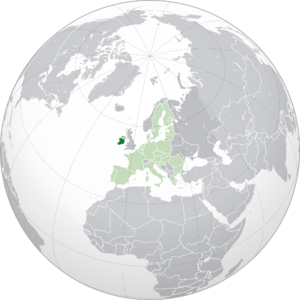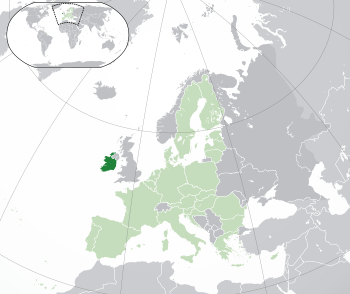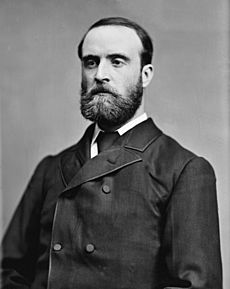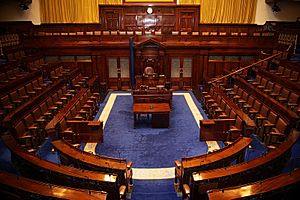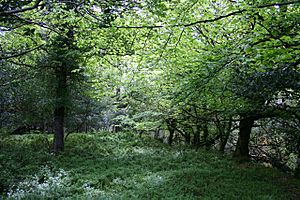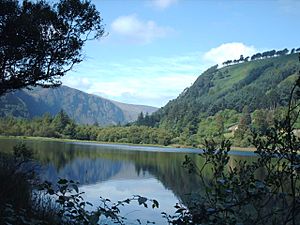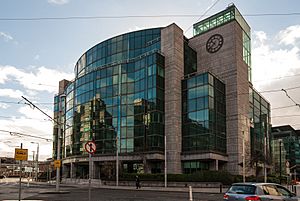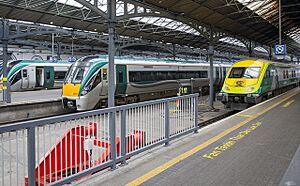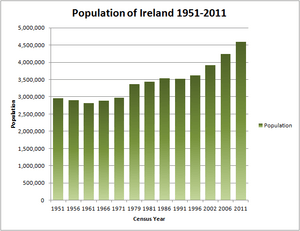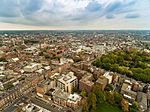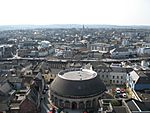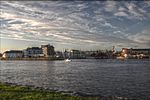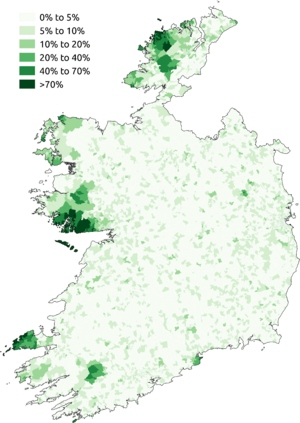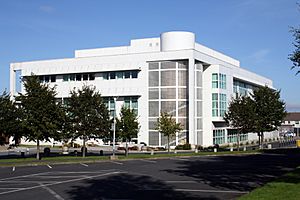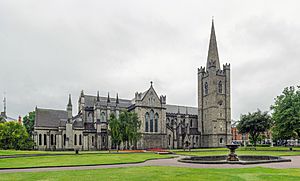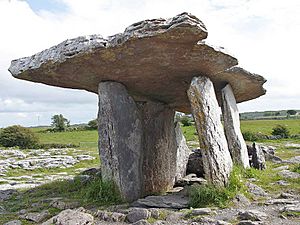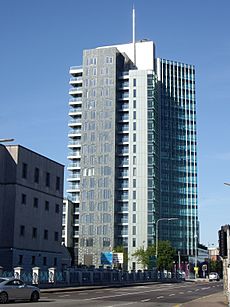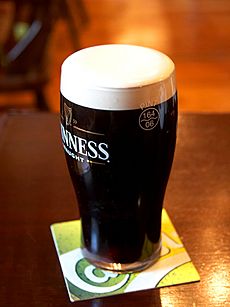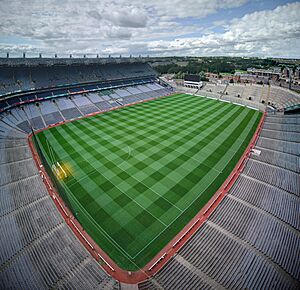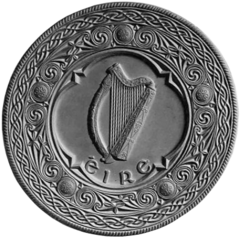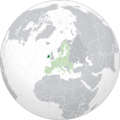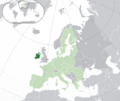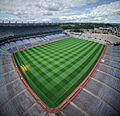Republic of Ireland facts for kids
Quick facts for kids
Ireland
Éire (Irish)
|
|
|---|---|
|
Location of Ireland (dark green)
– on the European continent (light green & dark grey) |
|
| Capital and largest city
|
Dublin 53°20.65′N 6°16.05′W / 53.34417°N 6.26750°W |
| Official languages | |
| Ethnic groups
(2022)
|
|
| Religion
(2022)
|
|
| Demonym(s) | Irish |
| Government | Unitary parliamentary republic |
| Catherine Connolly | |
| Micheál Martin | |
|
• Tánaiste
|
Simon Harris |
| Legislature | Oireachtas |
| Seanad | |
| Dáil | |
| Independence
from the United Kingdom
|
|
| 24 April 1916 | |
| 21 January 1919 | |
| 6 December 1921 | |
|
• 1922 constitution
|
6 December 1922 |
|
• 1937 constitution
|
29 December 1937 |
|
• Republic Act
|
18 April 1949 |
| Area | |
|
• Total
|
70,273 km2 (27,133 sq mi) (118th) |
|
• Water (%)
|
2.0% |
| Population | |
|
• April 2024 estimate
|
|
|
• 2022 census
|
|
|
• Density
|
76.6/km2 (198.4/sq mi) (113th) |
| GDP (PPP) | 2025 estimate |
|
• Total
|
|
|
• Per capita
|
|
| GDP (nominal) | 2025 estimate |
|
• Total
|
|
|
• Per capita
|
|
| Gini (2022) | ▲ 27.9 low |
| HDI (2023) | very high · 11th |
| Currency | Euro (€) (EUR) |
| Time zone | UTC (GMT) |
|
• Summer (DST)
|
UTC+1 (IST) |
| Date format | dd/mm/yyyy |
| Driving side | left |
| Calling code | +353 |
| ISO 3166 code | IE |
| Internet TLD | .ie |
Ireland (Irish: Éire [ˈeːɾʲə]), also known as the Republic of Ireland (Poblacht na hÉireann), is a country in north-western Europe. It covers most of the island of Ireland. The capital and largest city is Dublin, located on the eastern side of the island. About 2.1 million of the country's 5.15 million people live in the greater Dublin area.
Ireland shares its only land border with Northern Ireland, which is part of the United Kingdom. The rest of the country is surrounded by the Atlantic Ocean. To the south is the Celtic Sea, to the south-east is St George's Channel, and to the east is the Irish Sea. Ireland is a single country with a parliamentary republic government. The main law-making body, called the Oireachtas, has two parts: a lower house called Dáil Éireann and an upper house called Seanad Éireann.
Ireland also has an elected President (Uachtarán). The President is mostly a ceremonial head of state, but has some important duties. The head of government is the Taoiseach (which means "Chief" or Prime Minister). The Dáil elects the Taoiseach, and the President appoints them.
The Irish Free State was formed in 1922 after the Anglo-Irish Treaty. In 1937, a new constitution was put in place. This constitution named the state "Ireland" and made it a republic with an elected president. In 1949, it was officially declared a republic. Ireland joined the United Nations in 1955 and the European Communities (which later became the European Union) in 1973.
For most of the 20th century, Ireland had no formal relations with Northern Ireland. However, in the 1980s and 1990s, the Irish and British governments worked together to solve the conflict known as the Troubles. Since the Good Friday Agreement was signed in 1998, the governments of Ireland and Northern Ireland have worked together on many issues.
Ireland is a developed country with a very high quality of life. It ranks high in healthcare, economic freedom, and freedom of the press. It is a member of the EU, the Council of Europe, and the OECD. Ireland has chosen to be militarily neutral since before World War II. This means it is not a member of NATO.
Ireland has a strong economy, with Dublin being a major financial hub in Europe. It is one of the wealthiest countries in the world. After joining the European Communities, Ireland's government introduced economic policies that helped its economy grow very fast between 1995 and 2007. This time is often called the Celtic Tiger period. There was a recession after that, but the economy has grown strongly again since 2014.
Contents
Understanding Ireland's Name
The state created in 1922 was called the "Irish Free State." In 1937, a new constitution was adopted. This constitution stated that "the name of the State is Éire, or, in the English language, Ireland."
In 1948, a law was passed that said the state should be described as "the Republic of Ireland." This law did not officially name the state "Republic of Ireland" to avoid conflict with the Constitution.
The United Kingdom government used the name "Eire" (without the accent) and later "Republic of Ireland" for the state. It was only after the Good Friday Agreement in 1998 that they started using the name "Ireland."
Besides "Ireland" or "the Republic of Ireland," the country is sometimes called "the Republic," "Southern Ireland," or "the South." In some contexts, it is also called "the Free State" or "the 26 Counties."
A Brief History of Ireland
Ireland was part of the United Kingdom of Great Britain and Ireland from 1801 until 1922. A terrible event called the Great Famine happened between 1845 and 1849. During this time, the island's population dropped by 30%. One million Irish people died from starvation or disease, and another 1.5 million moved away, mostly to the United States. This led to a steady decline in population until the 1960s.
From the late 1800s, the Irish Parliamentary Party became very important. They worked to get land reforms for farmers and tried to achieve Home Rule. Home Rule would have given Ireland some control over its own affairs. This idea became very likely in 1914, but its implementation was put on hold because of World War I.
Steps Towards Independence
In 1916, during World War I, a group called the Irish Volunteers and the Irish Citizen Army started an armed uprising against British rule. This event, known as the Easter Rising, began on April 24, 1916, with a declaration of independence. After a week of fighting in Dublin, the rebels surrendered. Many were imprisoned, and fifteen leaders were executed. These events, along with a plan to force Irish men to join the British army in 1918, greatly changed public opinion in Ireland.
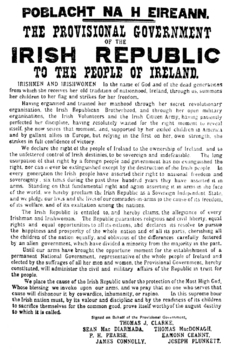
In January 1919, after an election, 73 Irish Members of Parliament (MPs) who were part of Sinn Féin refused to go to the British Parliament. Instead, they formed their own Irish parliament called Dáil Éireann. This first Dáil declared an Irish Republic.
After the Irish War of Independence and a truce in 1921, British and Irish leaders negotiated the Anglo-Irish Treaty. This treaty was approved by a small margin in the Dáil.
On December 6, 1922, the entire island of Ireland became a self-governing area called the Irish Free State. However, Northern Ireland had the option to leave the Irish Free State and rejoin the United Kingdom, which it did on December 8, 1922. The Irish Free State was a constitutional monarchy with a monarch shared with the United Kingdom.
The Irish Civil War
The creation of the Irish Free State led to the Irish Civil War. This war was fought between those who supported the Anglo-Irish Treaty and those who did not. The anti-treaty side, led by Éamon de Valera, believed the treaty betrayed the idea of a fully independent Irish Republic. They did not want to remain part of the British Empire or swear loyalty to the British King.
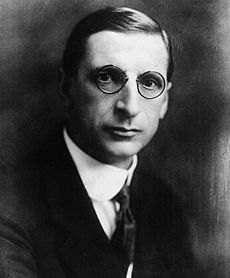
The pro-treaty side, led by Michael Collins, argued that the treaty gave Ireland the freedom to achieve full independence later. The pro-treaty forces, with support from the British, were able to build a strong army and defeat the anti-treaty forces. The war ended in 1923.
Becoming a Republic
On December 29, 1937, a new Constitution of Ireland came into force after a national vote. This constitution replaced the old one and named the state Ireland, or Éire in Irish. It also created the office of President of Ireland.
Ireland remained neutral during World War II. Its link with the Commonwealth ended in 1949 when the Republic of Ireland Act 1948 declared the state a republic.
Recent History and Growth
Ireland became a member of the United Nations in 1955. In 1973, Ireland joined the European Economic Community (EEC), which later became the European Union (EU). This was a big step for Ireland's economy.
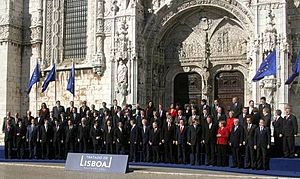
The Irish economy grew very quickly in the late 1990s, a time known as the Celtic Tiger period. This growth lasted until the global financial crisis of 2007–08. After a difficult period, Ireland's economy has seen strong growth again since 2014.
In 1998, a peace agreement for Northern Ireland, called the Good Friday Agreement, was approved by people both north and south of the border. As part of this agreement, Ireland removed its claim to Northern Ireland from its constitution.
Geography and Climate
Ireland covers about five-sixths of the island of Ireland. The country is bordered by the Atlantic Ocean to the north and west. To the northeast is the North Channel. The Irish Sea is to the east, connecting to the Atlantic Ocean through St George's Channel and the Celtic Sea to the southwest.
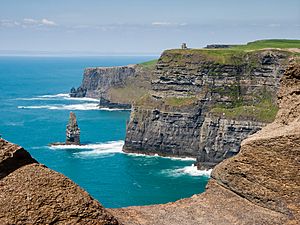
The western part of Ireland has rugged cliffs, hills, and mountains. The central lowlands have a lot of clay and sand left by glaciers, as well as many boglands and lakes. The highest point is Carrauntoohil, which is 1,038 meters (3,406 feet) tall. It is in the MacGillycuddy's Reeks mountain range in the southwest. The River Shannon is the longest river in Ireland, flowing for 386 kilometers (240 miles) through the central lowlands. The west coast is more rugged than the east, with many islands, peninsulas, and bays.
Thousands of years ago, Ireland was mostly covered by forests. Over time, much of this woodland was cleared for farming. Today, about 12% of Ireland is forested, mostly with coniferous trees grown for commercial use. Ireland's soil, rainfall, and mild climate are great for growing forests. Hedgerows, which are traditional boundaries, are important for wildlife, providing homes for insects, birds, and mammals.
Agriculture uses about 64% of the land. This means there is less natural habitat for wild animals, especially larger ones. Modern farming methods, like using pesticides and fertilisers, also put pressure on biodiversity.
Ireland's Weather and Climate
The Atlantic Ocean and the warm Gulf Stream greatly affect Ireland's weather. Temperatures are generally mild, rarely dropping below -5°C (23°F) in winter or rising above 26°C (79°F) in summer. The highest temperature ever recorded was 33.3°C (91.9°F) in 1887, and the lowest was -19.1°C (-2.4°F).
Rainfall is more common in winter and less in early summer. Southwestern areas get the most rain because of southwesterly winds, while Dublin gets the least. The sunniest months are May and June. The far north and west are very windy, making them good for wind energy.
Understanding Ireland's Politics
Ireland is a republic with a parliamentary system of government. The Oireachtas is the national parliament. It includes the President of Ireland and two houses: Dáil Éireann (the lower house) and Seanad Éireann (the upper house). The President lives at Áras an Uachtaráin, and the Oireachtas meets at Leinster House in Dublin.
The President is the head of state. They are elected for a seven-year term and can be re-elected once. The President's role is mostly ceremonial, but they have some important powers. For example, they can ask the Supreme Court to check if a new law follows the constitution.
The Taoiseach (Prime Minister) is the head of government. The President appoints the Taoiseach after the Dáil nominates them. Usually, the Taoiseach is the leader of the political party that wins the most seats in elections. Since 1989, governments have often been formed by coalitions of several parties.
The Dáil has 174 members, called Teachtaí Dála. They are elected from different areas using a system called proportional representation. The Seanad has 60 members. Some are chosen by the Taoiseach, some are elected by universities, and others are elected by public representatives.
The government can have up to fifteen members. Most must be from the Dáil. The Dáil must hold a new election at least every five years.
Ireland has been a member state of the European Union since 1973. People from the United Kingdom can enter Ireland without a passport because of the Common Travel Area. This is a special zone that includes Ireland, Great Britain, the Isle of Man, and the Channel Islands.
Ireland's Economy
Ireland has an open economy, meaning it trades a lot with other countries. It is a top country for "high-value" foreign direct investment (FDI). This means many international companies choose to invest and set up businesses in Ireland. Ireland ranks very high in GDP per person and GNI per person.
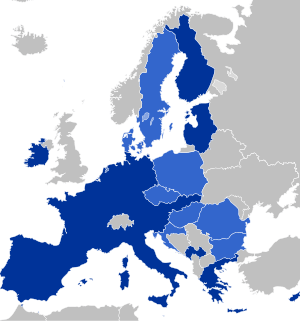
Foreign multinational companies are a big part of Ireland's economy. They employ a quarter of the private sector workforce and pay a large portion of corporate taxes. Many of the top companies in Ireland are US-based multinational firms.
Ireland adopted the Euro currency in 2002, along with eleven other EU countries. As of January 2023, 20 EU countries use the euro.
After the Great Recession and a housing market crash, Ireland's economy started to grow again in 2010. This was helped by exports from US multinational companies. However, the Irish government had to accept financial help from the EU and International Monetary Fund (IMF) due to banking debt. Ireland successfully exited this bailout program in 2013.
Ireland has become a popular location for large US technology companies like Apple, Google, Microsoft, and Facebook. This is partly because of Ireland's low corporate tax rates.
Trade and Industry
Even though multinational companies lead Ireland's export sector, other businesses also contribute a lot. Ireland is one of the biggest exporters of medicines, medical devices, and software. Large Irish companies like Ryanair and Kerry Group also export many goods. Ireland has natural resources like zinc, lead, and gypsum.
Tourism in Ireland is also important, making up about 4% of the country's GDP and providing many jobs. Other exports include food, cattle, beef, and dairy products. Ireland mainly imports data processing equipment, chemicals, and petroleum products.
The EU is Ireland's biggest trading partner. Before Brexit, the United Kingdom was the most important trading partner within the EU. Outside the EU, the United States is a major trading partner.
Energy in Ireland
ESB, Bord Gáis Energy, and Airtricity are the main electricity and gas suppliers in Ireland. The country has natural gas reserves, and there are efforts to increase the use of renewable energy, especially wind power. Many wind farms have been built, some to export electricity.
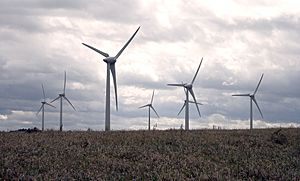
The Sustainable Energy Authority of Ireland (SEAI) reported that 6.5% of Ireland's energy in 2011 came from renewable sources. They also noted that carbon emissions per house decreased by 28% from 2005 to 2013, showing improved energy efficiency. In 2021, Ireland was the 24th largest wind energy producer in the world.
Getting Around: Transport
Ireland has three main international airports in Dublin, Shannon, and Cork. These airports serve many flights to Europe and other continents. The flight route between London and Dublin is one of the busiest international air routes in the world. Aer Lingus is Ireland's national airline, but Ryanair is the country's largest airline and Europe's biggest low-cost carrier.
Iarnród Éireann (Irish Rail) operates all train services within Ireland, including intercity, commuter, and freight trains. Dublin is the center of the railway network. The Enterprise service connects Dublin and Belfast. Dublin's public transport includes the DART train, Luas trams, and Dublin Bus.
Motorways and national roads are managed by Transport Infrastructure Ireland. The road network mainly connects to the capital, Dublin, but motorways also link it to other major cities like Cork, Limerick, Waterford, and Galway.
People and Culture
Ireland's population was 5,149,139 in 2022, an increase of 8% since 2016. In 2011, Ireland had the highest birth rate in the European Union. The median age of the Irish population in 2018 was 37.1 years.
In 2022, there were 631,785 non-Irish nationals living in Ireland. The largest groups came from Poland, the UK, India, Romania, and Lithuania.
| # | Settlement | Population | # | Settlement | Population | ||
|---|---|---|---|---|---|---|---|
| 1 | Dublin | 1,263,219 | 11 | Ennis | 27,923 | ||
| 2 | Cork | 222,526 | 12 | Carlow | 27,351 | ||
| 3 | Limerick | 102,287 | 13 | Kilkenny | 27,184 | ||
| 4 | Galway | 85,910 | 14 | Naas | 26,180 | ||
| 5 | Waterford | 60,079 | 15 | Tralee | 26,079 | ||
| 6 | Drogheda | 44,135 | 16 | Newbridge | 24,366 | ||
| 8 | Dundalk | 43,112 | 17 | Balbriggan | 24,322 | ||
| 7 | Swords | 40,776 | 18 | Portlaoise | 23,494 | ||
| 9 | Navan | 33,886 | 19 | Athlone | 22,869 | ||
| 10 | Bray | 33,512 | 20 | Mullingar | 22,667 |
Languages Spoken in Ireland
The Irish Constitution says that Irish is the "national language" and the "first official language." However, English is the main language spoken. In 2016, about 1.75 million people (40% of the population) said they could speak Irish, but fewer than 74,000 spoke it daily. Irish is mainly spoken as a community language in a few rural areas called the Gaeltacht.
Road signs are usually in both Irish and English, except in Gaeltacht regions. Most public signs and newspapers are only in English. Even though Irish is an official language, people sometimes find it hard to get government services in Irish.
Irish language media includes the TV channel TG4, the radio station RTÉ Raidió na Gaeltachta, and the online newspaper Tuairisc.ie. In the Irish Defence Forces, all drill commands are given in Irish.
Because of immigration, Polish is the most spoken language in Ireland after English, with Irish being the third most spoken. Many other European languages are also spoken daily. Most secondary school students learn one or two foreign languages like French, German, Italian, or Spanish. Learning Irish is usually required for students, but some can be excused in certain situations.
Healthcare in Ireland
Healthcare in Ireland is provided by both public and private services. The Minister for Health sets the overall health policy. Everyone living in Ireland can get healthcare through the public system, which is paid for by taxes. Sometimes, people might have to pay a small fee for certain services, depending on their income, age, or health condition. All maternity services are free, as is care for children up to 6 months old. Emergency care is free for patients who go to a hospital emergency department.
If you have a European Health Insurance Card, you can get free hospital treatment in public hospitals. Private health insurance is also available for those who want it.
In 2021, the average life expectancy in Ireland was 82.4 years. Ireland has a high birth rate and a very low infant mortality rate.
Education System
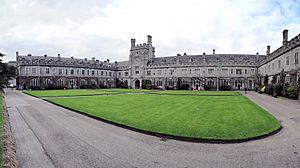
Ireland's education system has three levels: primary, secondary, and higher education. The Minister for Education oversees these systems. Children must attend school between the ages of six and fifteen. All children up to eighteen must complete the first three years of secondary school and take the Junior Certificate exam.
There are about 3,300 primary schools in Ireland. Most of them (92%) are run by the Catholic Church. Schools run by religious groups that receive public money cannot discriminate against students based on their religion.
The Leaving Certificate is the final exam in secondary school. Students who want to go to university usually take this exam. Access to university courses depends on their results. Ireland has many higher education institutions, including seven universities. According to 2022 rankings, Ireland is among the top twenty best countries for education.
Ireland ranks high in reading, science, and math scores among OECD countries. Primary, secondary, and university education are free in Ireland for all EU citizens, though there are fees for student services and exams. Also, 37% of Ireland's population has a university degree, which is one of the highest percentages in the world.
Religion in Ireland
| Religion in the Republic of Ireland | ||||
|---|---|---|---|---|
| Religion | Percent | |||
| Catholic Church | 78.3% | |||
| Non-religious | 10.1% | |||
| Protestant | 4.2% | |||
| Muslim | 1.3% | |||
| Other | 6.1% | |||
Religious freedom is protected by Ireland's constitution, which has been secular since 1973. Christianity is the main religion. While Ireland is mostly Catholic, the percentage of people who identify as Catholic has decreased from 84.2% in 2011 to 78.3% in 2016.
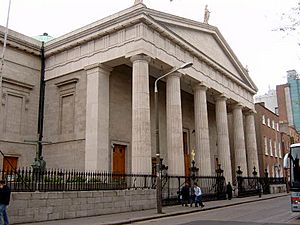
Other religions in 2016 included 4.2% Protestant, 1.3% Orthodox, 1.3% Muslim, and 9.8% with no religion. Orthodox Christianity and Islam were the fastest-growing religions.
Ireland's patron saints are Saint Patrick, Saint Bridget, and Saint Columba. Saint Patrick's Day is celebrated on March 17th in Ireland and worldwide as the Irish national day.
In 1972, the part of the Constitution that named specific religious groups was removed. The Constitution still states that "The State acknowledges that the homage of public worship is due to Almighty God." It also ensures freedom of religion and prevents the state from favoring any religion.
Irish Culture and Traditions
Ireland's culture was mainly Gaelic for centuries. It is one of the six main Celtic nations. After invasions and colonization, Irish culture was also influenced by English and Scottish cultures. Today, Irish culture is unique but shares traits with other English-speaking countries and Celtic regions. The Irish diaspora (Irish people living abroad) has helped spread Irish culture globally.
Irish Literature
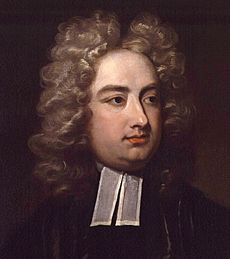
Ireland has contributed greatly to world literature in both English and Irish. Famous early writers include Jonathan Swift, known for Gulliver's Travels, and Oliver Goldsmith. Many Irish novelists appeared in the 19th century, including Bram Stoker, who wrote Dracula.
James Joyce (1882–1941) published his most famous work, Ulysses, in 1922. Other important novelists from the 20th century include Flann O'Brien, Elizabeth Bowen, and Edna O'Brien. More recent novelists include Roddy Doyle and Colm Tóibín.
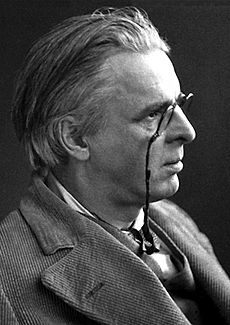
Well-known Irish poets include Patrick Kavanagh and Nobel Prize in Literature winners William Butler Yeats and Seamus Heaney. Famous Irish language writers include Máirtín Ó Cadhain.
Irish theatre has also made a big impact. In the 18th century, Oliver Goldsmith and Richard Brinsley Sheridan were very successful playwrights in London. In the 20th century, theatre companies focused on Irish plays. Famous Irish playwrights include Oscar Wilde, George Bernard Shaw, Samuel Beckett, and Seán O'Casey.
Music and Dance
Irish traditional music is still very popular and has kept many of its old styles. It has influenced other music types, like American country music and modern rock. Ireland has also produced many famous artists in rock, pop, jazz, and blues. The best-selling Irish music group is the rock band U2, who have sold 170 million albums worldwide.

Ireland has classical music groups and two opera organizations: Irish National Opera and the annual Wexford Festival Opera.
Ireland has won the Eurovision Song Contest seven times, which is more than any other country. The famous show Riverdance started as a performance during the 1994 Eurovision contest.
Irish dance has two main types: social dance and performance dance. Social dance includes céilí and set dancing, which are danced in groups. Irish stepdance, made famous by Riverdance, is known for its fast leg movements while the upper body stays mostly still.
Architecture and Buildings
Ireland has many old structures from the Neolithic period, like Brú na Bóinne and Poulnabrone dolmen. Since the Romans never conquered Ireland, there are very few buildings from that time. Instead, Ireland had a long period of Iron Age architecture. The Irish round towers were built during the Early Middle Ages.
Christianity brought simple monastic houses like Clonmacnoise. Castles were built by the Anglo-Normans in the late 12th century, such as Dublin Castle and Kilkenny Castle. They also introduced planned towns with walls. Many towns today, like Drogheda and Youghal, were planned this way.
Gothic cathedrals, like St Patrick's, were also built by the Normans. Later, elegant tower houses like Bunratty Castle were built. Many religious buildings were destroyed during the Dissolution of the Monasteries.
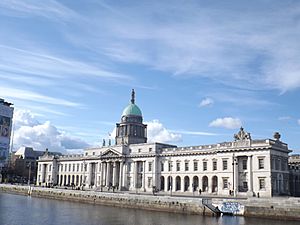
In the 18th century, neoclassical and Georgian styles became popular, especially in Dublin. Buildings like The Custom House and Four Courts were built in this style. Georgian townhouses created beautiful streets in Dublin, Limerick, and Cork.
Since the 20th century, Irish architecture has followed modern styles. Recent projects include the redevelopment of the Dublin Docklands, which includes the Convention Centre Dublin. The Elysian tower in Cork, completed in 2008, is the tallest building in the Republic of Ireland.
Media and Communication
Raidió Teilifís Éireann (RTÉ) is Ireland's public service broadcaster. It is funded by a television licence fee and advertising. RTÉ runs two national TV channels, RTÉ One and RTÉ Two. Other national TV channels include Virgin Media One, Virgin Media Two, Virgin Media Three, and TG4 (for Irish speakers). All these channels are available on Saorview, Ireland's free digital TV service.
The BBC's Northern Irish channels are also widely available in Ireland.
The Irish film industry has grown a lot since the 1990s, making Irish films and attracting international productions like Braveheart.
Many regional and local radio stations are available across the country. RTÉ Radio operates four national stations. There are also two independent national stations: Today FM and Newstalk.
Ireland has many newspapers, including daily national papers and weekly regional ones. British newspapers and magazines are also widely available. In 2013, 82% of Irish homes had Internet access.
Irish Food and Drink
Traditional Irish food is based on meat, dairy, vegetables, and seafood. Popular dishes include boxty, colcannon, coddle, stew, and bacon and cabbage. Ireland is also known for the full Irish breakfast, which usually includes bacon, egg, sausage, and pudding.
Recently, a new Irish cuisine has emerged. It uses traditional ingredients in new ways, focusing on fresh vegetables, fish, shellfish, and local cheeses. Popular fish include salmon and cod. Traditional breads include soda bread and wheaten bread.
Common drinks include tea and coffee. Famous alcoholic drinks from Ireland include Poitín and the world-renowned Guinness, a dry stout from Dublin. Irish whiskey is also very popular.
Sports in Ireland
Gaelic football and hurling are Ireland's traditional sports and are very popular to watch. They are managed by the Gaelic Athletics Association across the whole island. Other Gaelic games include Gaelic handball and rounders.
Association football (soccer) is the third most popular spectator sport and has the most participants. The Republic of Ireland national football team plays at international level.
Rugby union is also popular, played at local and international levels across Ireland. Famous players include Brian O'Driscoll. The Irish Cricket Team has become more popular after its success in the 2007 Cricket World Cup. Ireland is one of the twelve countries with Test status.
Golf is another popular sport, with over 300 courses. Ireland has produced successful golfers like Pádraig Harrington. Horse racing is also big in Ireland, with important breeding and racing operations.
Boxing is Ireland's most successful sport at the Olympic Games. It has gained popularity due to international successes by boxers like Katie Taylor.
Some of Ireland's top athletics performers have competed at the Olympics. The annual Dublin Marathon is a popular event. Other sports with a following in Ireland include cycling, greyhound racing, and motorsport.
Society and Values
Capital punishment (the death penalty) is banned in Ireland by its constitution. Discrimination based on age, gender, sexual orientation, marital status, religion, race, or being part of the travelling community is illegal. In 2015, Ireland became the first country to allow same-sex marriage by a public vote.
Ireland was the first country in the world to introduce a tax on plastic shopping bags in 2002 and a public smoking ban in 2004. Recycling in Ireland is common, and Ireland has one of the highest rates of packaging recycling in the European Union. It was also the first European country to ban incandescent lightbulbs in 2008 and ban in-store tobacco advertising in 2009. In 2015, Ireland became the second country to introduce plain cigarette packaging.
National Symbols
Ireland shares many symbols with the entire island of Ireland. These include the colors green and blue, animals like the Irish wolfhound and stags, structures like round towers and celtic crosses, and designs like Celtic knots. The shamrock, a type of clover, has been a national symbol since the 17th century and is worn on St. Patrick's Day.
The flag of Ireland is a tricolour with green, white, and orange stripes. The green represents the Gaelic tradition, and the orange represents the followers of William of Orange. The white represents the hope for peace between them. It was adopted as the flag of the Irish Free State in 1922.
The national anthem is Amhrán na bhFiann (A Soldier's Song). It has its roots in the Easter Rising. Although it was first published in English in 1912, the Irish version is more commonly sung today. It became the official anthem in 1926.
The arms of Ireland feature a harp. This symbol has been used for the King of Ireland since the 12th century. Today, it is the personal symbol of the President of Ireland and is used on official documents and Irish coins.
Images for kids
See also
 In Spanish: Irlanda para niños
In Spanish: Irlanda para niños




